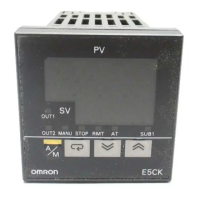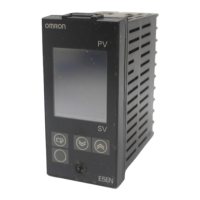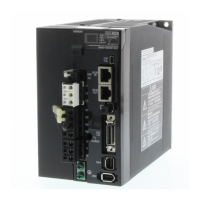Startup Procedure and
Test Run
4
4.6 Auto-Tuning
SIEPYEUOQ2A01A AC Drive Q2A Technical Manual 151
After Stationary Auto-Tuning is complete, use this procedures to do the operation in test mode:
1. Check the E2-02 and E2-03 values on the “Modified Parameters/Fault Log” screen or the “Parameters” screen.
2. Operate the motor in Drive Mode with these conditions:
• Do not disconnect the wiring between the motor and drive.
• Do not lock the motor shaft with a mechanical brake or other device.
• The maximum motor load must be 30% of the rated load.
• Keep a constant speed of 30% of E1-06 [Base Frequency] (default value = maximum frequency) or more
for 1 second or longer.
3. After the motor stops, check the E2-02 and E2-03 values on the “Modified Parameters/Fault Log” screen or
the “Parameters” screen again.
4. Make sure that the input data is correct.
When the settings in E2-02 and E2-03 are different than in step 1, the drive set the values automatically.
Note:
• If you cannot operate the motor with the conditions in step 2 for the first test run and if the values set in E2-02 and E2-03 are much
different than data in the official test report for the motor and the data listed in Defaults by Drive Model and Duty Rating ND/HD on
page 489, these problems can occur:
–Motor vibrations or hunting
–Not sufficient torque
–Overcurrent
In elevator applications, there is a risk of the cage falling and causing personal injury.
Do one of these precautions to decrease the risk:
–After doing Stationary Auto-Tuning, operate the drive as specified by the conditions and procedure above.
–Set T1-12 = 0 [Test Mode Selection = No].
–Do Rotational Auto-Tuning.
• If you initialize the drive after completing Step 1, do the procedure beginning from Step 1 again.
• For general-purpose motors, the target value for E2-02 is 1 Hz to 3 Hz, and the target rated current for E2-03 is 30% to 65%. Larger
capacity motors have a lower rated slip, and a smaller ratio for the no-load current rated current. Refer to Defaults by Drive Model and
Duty Rating ND/HD on page 489 for details.
■ Precautions before Stationary Auto-Tuning for Line-to-Line Resistance and Stator
Resistance Auto-Tuning
In V/f control, when the motor cable is 50 meters (164 feet), do Stationary Auto-Tuning for Line-to-Line
Resistance.
WARNING! Electrical Shock Hazard. In Stationary Auto-Tuning, the drive applies voltage to the motor. Do not touch the motor
until Auto-Tuning is complete. Failure to obey could cause serious injury.
■ Precautions before Inertia Tuning and ASR Tuning
Before Inertia Tuning or ASR Tuning, check these items:
WARNING! Electrical Shock Hazard. In Rotational Auto-Tuning, the drive applies voltage to the motor before the motor rotates.
Do not touch the motor until Auto-Tuning is complete. Failure to obey could cause serious injury.
• Do rotational motor parameter tuning or look at the motor test report or nameplate to enter the values manually.
• Make sure that the motor magnetic brake is released.
• Connect the motor and load.
• Make sure that external force from the machine will not cause the motor to rotate.
• Make sure that the machine does not prevent reverse rotation. You cannot do Inertia Tuning or ASR Tuning with
machines that prevent reverse rotation.
• When the motor can rotate during Auto-Tuning, check for safety issues near the drive, motor, and machine.
Note:
If there are gears between the machine and motor shaft, Inertia Tuning or ASR Tuning are possibly not applicable.
■ Precautions before Using Deceleration Rate Tuning and KEB Tuning
Before Deceleration Rate Tuning or KEB Tuning, check these items:

